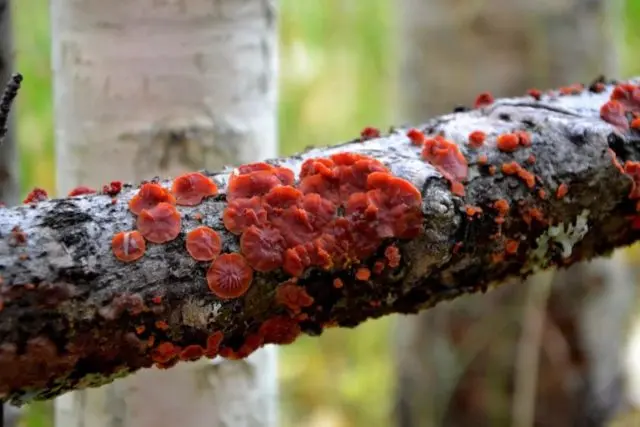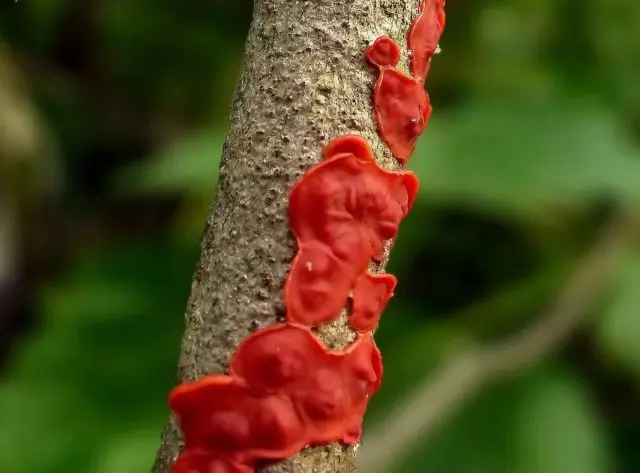Contents
The representative of the family Corticia willow cytidia (Stereum salicinum, Terana salicina, Lomatia salicina) is a tree-dwelling fungus. It parasitizes on the branches of old or weakened trees. It has no nutritional value, the mushroom is inedible.

Where does Cytidia Willow grow?
A perennial microscopic fungus can exist only in symbiosis with the wood of willow, poplar, and less often other hardwoods. The main distribution is on old weakened dying branches, it also grows on new deadwood.
Willow cytidia is common in warm and temperate climates. The main accumulation is in the forests of the Central regions, Siberia, the Urals. In the Krasnodar Territory, it is found in mountainous regions and the Black Sea coastal forests; in a warm climate, it bears fruit throughout the year. In a temperate climate, young fruiting bodies appear in spring, growth continues until late autumn. At high air humidity during the season, the fungus covers significant areas of the branches and trunk, on which it parasitizes.
In winter, the cytidia is at rest, old mushrooms do not die for about 3-5 seasons, they continue to spread along with young specimens. In dry weather, dying fruiting bodies lose moisture, become rigid, dry out significantly, and acquire the color of wood. You can see them only with a detailed examination of the branch section.

What does willow cytidia look like?
Willow Cytidia has a simple macroscopic fruiting body structure with the following characteristic:
- the shape of an irregular circle, the transverse length is 3-10 mm, it happens in the form of a thin smooth continuous film covering the wood surface;
- color – bright red or burgundy with a purple tint;
- at low humidity, perennial specimens have a leathery, wrinkled surface; during prolonged rains, they have a jelly-like consistency with an oily surface. Dry mushrooms – hard, horn-shaped, not losing color;
- the arrangement is prostrate, sometimes with raised edges, which are easily separated from the surface.

They begin to grow singly, over time they form small groups in different places of the tree bark. Growing, the groups are connected in a continuous line, reaching up to 10-15 cm.
Is it possible to eat cytidia willow
In biological reference books, cytidia willow is in the group of inedible species. There is no information on toxicity. But the thin fruiting body, which is initially stiff when dry and jelly-like during rainfall, is unlikely to arouse gastronomic interest.
Similar species
Close in appearance, mode of development and places of growth to cytidia willow phlebia radial. It parasitizes on dead wood of deciduous species, old deadwood.

A similar species is distinguished by a larger size of the fruiting body, forming wide or long conglomerates. The color is closer to orange, in dry weather a dark purple spot begins to increase from the central part and spread to the edges. When frozen, it may become completely black or colorless. The shape is rounded with serrated raised edges. The surface is bumpy. Mushrooms with an annual vegetation phase, inedible.
Application
Fruiting bodies are inedible, they are not used in any form for processing. In folk medicine, they also did not find application. In the ecological system, like any biological species, the fungus has a certain function. From symbiosis with dying wood, it receives the necessary trace elements for development, in turn, it inhibits the process of decay and decomposition of dead wood.
Conclusion
Willow saprotroph cytidia parasitizes on dry branches of deciduous trees, mainly willow and poplar. Forms long continuous conglomerates in the form of a red film. The mushroom is inedible, there is no information about toxic compounds in the chemical composition.









